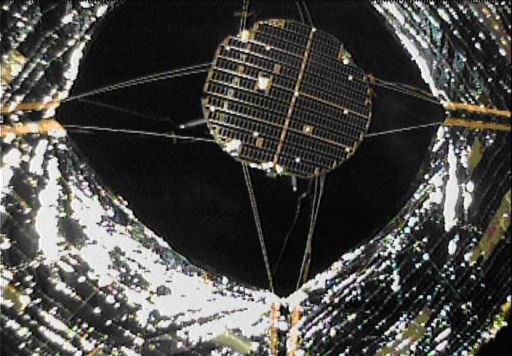[/caption]
Two small “separation cameras” were ejected from JAXA’s (Japan Aerospace Exploration Agency) IKAROS solar sail, which successfully took some amazing full images of the fully deployed sail. The cameras are quite small, cylindrical in shape about 6 cm in diameter and height. They were ejected from the sail using a spring, and then they looked back at IKAROS, and relayed the images wirelessly. The cameras are now floating off into space, having done their job of taking these images. Below, an animation, or movie made by combining several images.

We will measure and observe the power generation status of the thin film solar cells, accelerate the satellite by photon pressure, and verify the orbit control through that acceleration. Through these activities, we will ultimately aim at acquiring navigation technology through the solar sail.
So, now that we know the sail is fully deployed, next comes the big test of whether solar sailing will actually work. This is huge, to finally have the opportunity to test a solar sail in space.

From the IKAROS blog, speaking as the cameras:
Unfortunately I only have the battery, and…working time is very short for about 15 minutes after I do my best work is a planets around the Sun, the world’s smallest man-made flying with IKAROS continue.
Translation: these tiny cameras only had about 15 minutes to do their job of taking pictures before becoming dead little satellites orbiting around the sun.
IKAROS was launched on May 21, 2010 from the Tanegashima Space Center in Japan.
We’ll keep you posted as JAXA begins testing the solar sail.



True, and since IKAROS features a different design approach to the soon to be launched LightSail1 (for example spin stabilization versus booms to support the sail, differing sail material etc.), we will also see who has their technological nose in front (for example maximum acceleration per unit mass per unit intensity of light pressure).
There were only two camera’s? Dang… I want to see a CME slam into the sail…..~
It’s really great to see this blossoming of Japanese space and astronomy programs over the past several years. Japan is definitely a serious player in the arena of space exploration.
I’m just glad there was cameras up there, most missions can’t afford the extra weight, but thanks to new shrink size tech this is possible, got to hand to JAXA, they have done a great job on this mission.
If only there were minicams like this on Apollo 13.
This is all well and good to get great pictures; but to throw the cameras out into space is yet another example of how the space industry in general looks at space as one big Dumping ground. WE NEED TO BE MORE RESPONSIBLE!!!!!!
Wow – Nice.
@starhope
We do, but we should be happy with the fact that its not LEO that the cameras are being dumped to.
Space is pretty huge. Posting an exterior camera is like a piece of driftwood in the Pacific. Sure, it can conceivably do damage – smack into a spaceship, station, or satallite, but to say it’s unlikely is the understatement of the century. I’d be interested in hearing reasonable alternatives.
LOL, not to mention all that rubble that clutters the ultimate dumping ground – dust, asteroids, planets and suns. I demand more SMBHs for to vacuum the stuff!
There is a SOLAR SAIL, in space, right now, lets not take from that.
This really is a dream come true for all us space travel enthusiasts. If we can harness controlled acceleration by photon pressure, the possibilities are mind-boggling.
This might sound dumb, but how is this thing going to Venus? Is it reasonable to assume that Solar Sail craft can only go outwards from earth (i.e Mars and beyond)? Surely going to venus would literally be like sailing into the wind?
Thats a good question, I have no idea myself but I assumed it was like sail ships that sail into the wind, which I think depends on the design and direction of your sail, must google this.
@ idlelimey
Got this on another site,
To travel towards the Sun you need to reduce your orbital velocity. To do that you tilt the solar sail to get a net braking force.
Thank you Spoodle58, I had been scratching my head about that one.
This is so cool! And to combine the sail with an ion drive was inspired, I hope this generates good results and solar sails can be used in conjunction with other forms of propulsion to extend the range of our probes, or to reduce fuel costs/weight (more room for instruments!).
Well done JAXA.
Or even an interstellar probe, now that would something, even if wasn’t to reach its destination in my lifetime it would be honor to witness such an event begin.
Yes, the IP capability is interesting.
One concern in project Daedalus et cetera is that exploration (or migration) should give ROI within a lifetime because it is so expensive. But what if it is cheap? I dunno about sails seeding biospheres, but exploration is now reasonable in the same way as planting trees for future generations.
I completely agree.